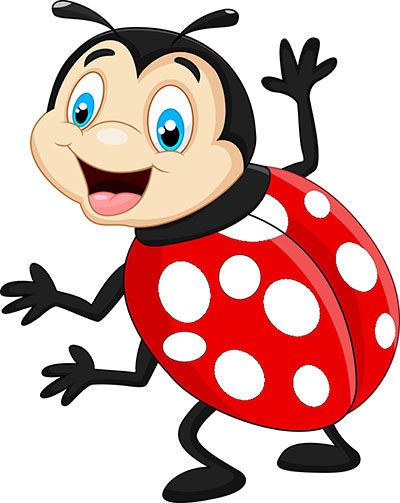Below you will find stories, songs, activities, and lesson plans about numbers and counting. These complement your On My Way to Kindergarten activity book and help practice skills to master before kindergarten. They work great for one child, a small group, or an entire classroom!
Try the Molina 1-1-1: choose 1 story, 1 song, and 1 activity. This will give little ones lots of opportunities to practice skills while learning about numbers and counting. You can stick with numbers and counting for a few days, or try some of our other activity areas like Three Little Pigs, Alphabet or Bodies and Senses.
Do you have more ideas of activities, stories or songs we might include? Click here to share. If your recommendation is chosen to add to our website, we’ll give you credit and send you a gift!
Stories
Learn all about numbers with these fun and interactive stories. Pause often and point out the numbers.
Bear Counts (5:00)
Adivinar Jugando con las 15 Adivinanzas y Acertijos de Comidas – Video para Niños
Elefante se Columpiaba y más Canciones. Cleo&Cuquín | Familia Telerín. Canciones Infantiles
123 to the Zoo (6:29 minutes)
La Canción de los Números
Chicka Chicka 123 (8:38)
La Reina de los Mares. Cleo & Cuquín | Familia Telerín.
Count with Maisy Cheep Cheep Cheep (4:42)
Infantil 22 Tengo Una Muñeca Vestida De Azul
The Crayon’s Book of Numbers Bilingual Edition (3:16 minutes)
Songs
Make up your own songs or try some of these to learn more about numbers and counting.
5 Monkeys Jumping on the Bed
5 Monitos – Canciones Infantiles
Alice the Camel
Canción de los Números – Canciones Infantiles – Toobys
5 Little Ducks
¡Aprenda Formas, Colores y Números para Niños con un Pastel de Cumpleaños de Juguete!
The Ants Go Marching
Contando del 1 al 20 | Números | PINKFONG Canciones Infantiles
Ten in the Bed
Canciones Infantiles para Aprender los Números, los Colores y las Formas | ¡LittleBabyBum!
Sesame Street: Feist Sings 1, 2, 3, 4
En Toobys Encontrarás las Mejores Canciones Infantiles. Enseña a Contar Hasta 10 con esta Hermosa Canción.
Sesame Street: Number of the Day
Playlist
Stuck in a car for a while? Sitting in the waiting room? Waiting at the bus stop? We have built a playlist on YouTube with songs and stories all about the Numbers and Counting.

Games and Activities
One Potato, Two Potato
A super fun counting game…all about potatoes!
- Make a fist with one hand. Hold your hand in front of your body and say, “One potato!”
- Keep your first fist in the same position and bring your second fist up and place it on top. Say, “Two potato!”
- Take your bottom fist and plonk it on top and say, “Three potato!”
- Now keep climbing higher and higher, keep doing this along with a counting rhyme:
One potato, two potatoes, three potatoes, four!
Five potatoes, six potatoes, seven potatoes, more! - When you get to “More!” say it loudly and excitedly. Open your hands, and wiggle your fingers bringing your hands back down to the starting position.

You can also do this with a partner. Each takes a turn “adding a potato” to the stack. You should be able to get to “Four” before someone needs to bring their bottom fist to the top of the pile. Take turns going first.
If you have a potato at home, let the little ones play with a real potato.
Practiquen los Números
Aprendiendo los números utilizando palitos de madera para paletas y bolitas de plastilina:
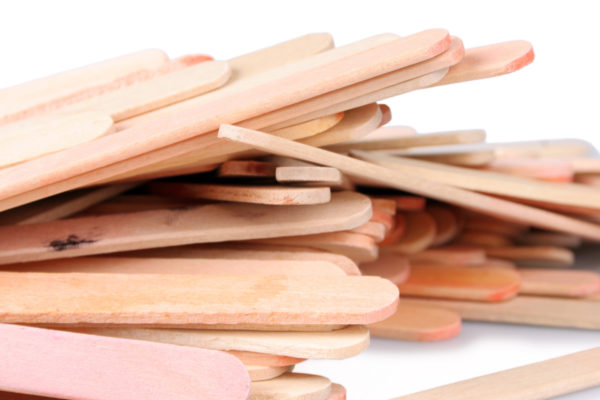
- Tome varios palitos de madera para paletas y pinte o dibuje números del 1 al 10 en la parte superior, un número por cada palito.
- Déselas a los niños y pídales que peguen en el la parte de en medio, la cantidad de bolitas de plastilina que corresponda al número que aparece; además de la plastilina se pueden usar papelitos de colores, frijoles, etc. para indicar el número.
Con esta actividad, los niños desarrollarán sus habilidades numéricas. Una vez que demuestren haber aprendido los números del 1 al 10, agrege números más grandes para continuar con el aprendizaje.
Crazy Dinosaurs Poem
Stretch out your fingers and use them to count as you say this silly poem:
Five crazy dinosaurs
Cleaning up the floor.
One got swept away
And then there were four.
Four crazy dinosaurs
Chased by a bee.
One got stung
And then there were three.
Three crazy dinosaurs
Playing with some glue.
One got stuck
And then there were two.
Two crazy dinosaurs
Out for a run.
One fell down
And then there was one.
One crazy dinosaur
Acting like a hero,
Went to save the others
And then there were zero.

Aprendiendo Los Números Utilizando Un Juego de Dominó
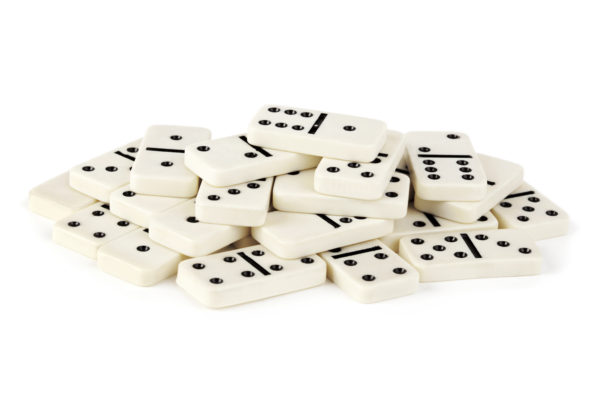
- Para empezar, elabore las fichas de dominó utilizando lápices, crayones y cartulinas.
- Una vez que se tengan las fichas hechas, siéntese con los niños y déles a cada uno de ellos, un total de cinco fichas.
- Coloque el resto de las fichas en el centro de la mesa.
- El primero en participar deberá poner una de sus fichas, el siguiente tendrá que colocar una ficha junto a ella que tenga el mismo número de puntos.
- En caso de no tener una ficha que concuerde con la de su compañero (a), el niño (a) deberá tomar una pieza del montón y ceder su turno al siguiente niño (a) que esté participando. La misma dinámica continúa hasta que uno de los niños se quede sin fichas.
Esta es una actividad divertida y diferente la cual enseñará a los niños a contar y a sumar puntos, al mismo tiempo que mejorarán su capacidad de asociación al tener que encontrar las fichas que correspondan con el número de puntos.
Number Scavenger Hunt
Create a fun number scavenger hunt to match numbers with the items around your house.
Materials:
- 10 index cards, or 10 pieces of paper or cardboard cut into the same sizes
- Markers
- Various items from around your house
-
- On each card write a number, and draw that number of dots on the card. For example, one card can have the number 2 on it and have two large dots drawn on it.
- Make a card for each number: 1, 2, 3, 4, 5, 6, 7, 8, 9, 10.
- Shuffle the cards. Choose one from the pile.
- Work with the child to identify the number card they were given. (If they don’t recognize the number yet, they can count the dots.) Then send them off to find that many items. For example, if they have the “2” card, your child might bring back 2 shoes or 2 forks.
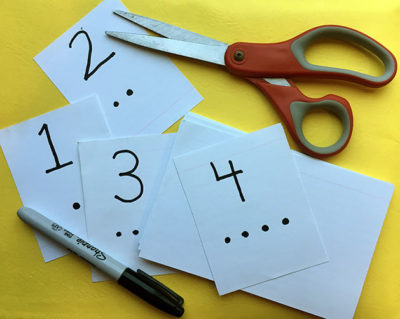
4. Set the items up on the floor and then, let them pick a new card with a new number and do the same.
5. When they bring back the second bunch, have them decide if there are MORE or LESS than the pile that is on the floor.
- If there are MORE, put the new pile to the right.
- If there are LESS, put the new pile to the left.
6. Continue this until you have a row of items on the floor that go from 0 on the left to 10 on the right. What an awesome scavenger hunt!
Too easy? Try bigger numbers, or just odd or even numbers.
Aprendiendo Los Números Utilizando un Rompecabezas
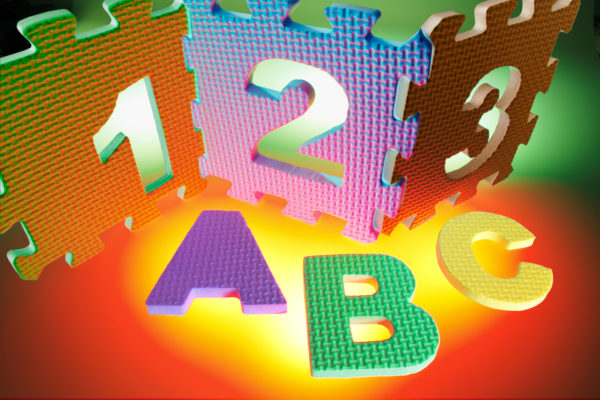
- Para empezar, elabore las piezas del rompecabezas utilizando lápices, crayones y cartulinas.
- En cada pieza dibuje o pinte un número, en otra la palabra del mismo número, en otra figuras, en otra formas, etc. Cada pieza debe de tener el mismo número de elementos que se esté representando.
- Una vez que se tengan hechas las piezas, siéntese con los niños y pídales que coloquen las piezas que correspondan al número que se muestre para así formar un rompecabezas que contenga todos las figuras, palabras, etc. de cada uno de los números.
Esta es una actividad divertida que enseñará a los niños a aprender a asociar números con la cantidad que estos representan, al mismo tiempo que reforzará sus habilidades numéricas.
Popsicle Stick Matching Game
Popsicle sticks make counting fun!
Materials:
- 20 popsicle sticks
- Markers, including one black marker
- Lay 10 sticks vertically on the table. Number each stick from 1 to 10 in bold, black letters.
- Then, on the remaining 10 sticks, make designs using different shapes and colors. Just make sure that the number of shapes on each stick
matches the numbers in the other set. For example, on one stick you may have one circle; on the next, two hearts; then three stars, until you get to ten. You can drawhearts, circles, squares, fish, etc. - When the sticks are ready, mix them up and give them to your child. Challenge them to pair the numbered sticks with their matching counterparts.
- After they have matched up all the sticks, look at the different shapes. Can they name the shapes on all the different sticks?
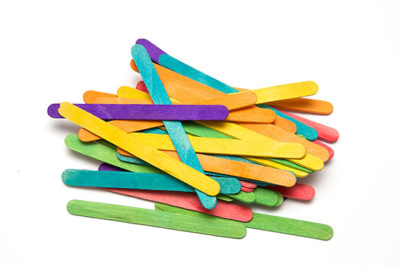
Spinning Number Wheel
This game combines arts and crafts with numbers.
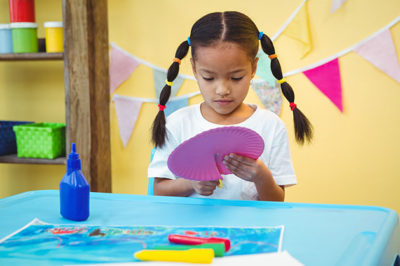
Materials:
- Two paper plates (colorful plates are nice if you have them)
- Black marker or stickers of numbers 1-12
- Either a pushpin and some sticky tack, or a round-head fastener
- On the first plate, write the numbers 1-12 around the outside edge (or stick numbers around the outside edge of the plate). Like a clock, put 12 at the top, 6 at the bottom, and then fill in the other numbers.
- Cut a rectangle out of the edge of the second plate. It should be just large enough to expose one number at a time.
3. Place the plate with the cut-out over the top of the one with the numbers.
4. Connect the two plates so they can turn. Either:
- Add a ball of sticky tac in the center of the plate with the numbers. Then, push a push pin through the middle and onto the sticky tac.
- Push the round-head fastener through both plates and secure it. The child should be able to turn the plates to show different numbers, one at a time.
Now, ask questions that can be answered by the Spinning Number Wheel:
- Can you find the number that shows how old you are?
- Can you use the spinner to count around the circle from 1-12 and then 12-1 again?
- Can you show me the numbers in our address? In our phone number?
- Can you show me how many fingers you have? How many toes?
Use the plate spinner to answer these questions and make sure to make up as many questions as you can!
Pasta Flip Books
You’ll need:
- Dry pasta (e.g. macaroni, spiral noodles, bowties, wheels, all work)
- White paper
- Scissors
- Marker
- Glue
- Crayons
- Hole Punch
- Yarn
To Prepare: Make a set of number cut-outs (1-10) for each child. On a piece of white paper, make a thick outline of each number. Make them approximately the same size. Cut them out.
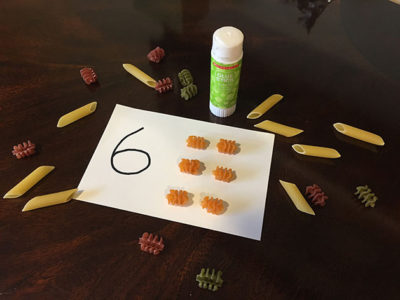
You can do this project in one day, or you can spend 10 days doing it — one new number each day for 10 days.
- Start with the number 1. If you cut “1” out of construction paper, give that to your child. Or, write the number on a large card/piece of paper..
- Ask your child to color the number.
- Ask your child to count out 1 piece of pasta.
- Glue 1 piece of pasta to the number 1. Set aside to dry.
- Ready for Number 2? Give the cut-out of the number 2 to your child, or write the number on a large card/piece of paper.
- Color the number.
- Count out 2 pieces of pasta.
- Glue the 2 pieces of pasta to the number 2. Set aside to dry.
- Continue this with each number.
- After you’ve made all 10 cards, punch a hole in the top of each number and thread the yarn through the numbers.
- Now each child as a number pasta flip book!
Sticker Fun
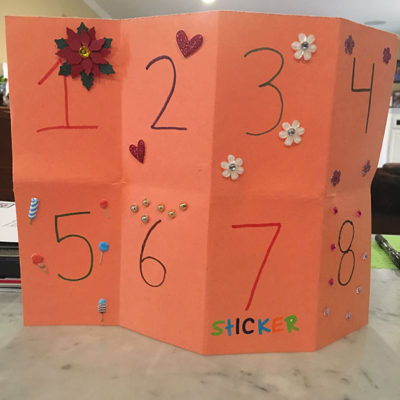
You’ll need:
- 1 sheet of paper
- Sheet of stickers (at least 36 stickers per child)
- Marker
- Fold the paper into 8 boxes. To do this, fold it in half 3 times. There’s many ways to do this – for example, first fold it horizontally. Then fold it into quarters. And then one more fold will get you 8 boxes.
- Unfold the paper. Write number 1 in the first box; 2 in the next box; and so on until all 8 boxes are labeled.
- Choose stickers for each box, corresponding with the number. In the first box, choose one sticker to place in the box. In the second box, choose two stickers, and so on.
Clothespin Counting Snacks
Begin learning number order and sizes. This make a great snack for a road trip or a day at the park!
Materials:
- 11 clothespins that have a spring to hold them closed
- Pen/marker/paint pen
- 11 small snack-sized resealable bags
- 55 small snack foods: raisins, pretzels, cheese crackers, animal crackers, etc.
- Use the marker or pen to number the clothespins 0 through 10. Each clothespin should have a different number.
- Once the numbers are dry, mix up the clothespins and work together to lay them on a table in order. Coach gently as needed, perhaps scooting a misplaced clothespin out of line and encourage counting out loud to review number order.
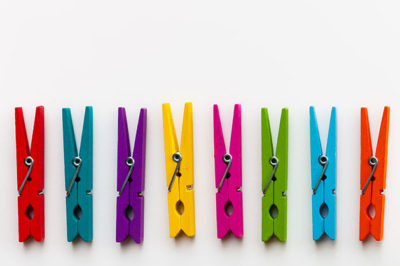
3. Inside 11 snack-sized zippered bags, count together the appropriate number of raisins, pretzels or crackers (1, 2, 3…through 10) and clip them to the appropriate clothespin. For the clothespin labeled 0, clip an empty bag.
4. Take your clothespin snacks with you to the park, on a road trip, or lay them out for the day. Each time your child wants a snack, choose one of the clothespins and count the items.
Fruit Salad or Finger Vegetable Salad
Put the kids in charge of making lunch!
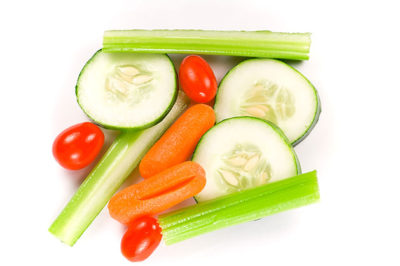
You’ll need:
- 5 different types of fruit or 5 different types of vegetables
- 5 bowls
- Bowls to serve the salads to guests
- Small pieces of paper (sticky notes work great)
- Marker
To prepare:
- Set out 5 different fruits or 5 different vegetables on the counter, prepared and ready to be served.
- Next to each bowl, place a sticky note with a number on it for how many of that item should be included in each bowl. For example, 1 next to the banana slices, 2 next to strawberries, 3 next to the cherries, 4 next to orange slices, and 5 next to blueberries.
- Wash your hands.
- Count how many people will be joining you for your meal. Make sure you have a bowl for each person.
- Build your salads! In each bowl, put the corresponding number of items. For example, if the bowl with blueberries is labeled with a 5 – put 5 blueberries in each bowl.
Math in the Kitchen
Cooking together is a fun – and delicious – way to practice numbers, counting and measuring. Children are great at measuring ingredients and counting different foods on your plate!
Here are a few simple recipes that might be fun to make together:






